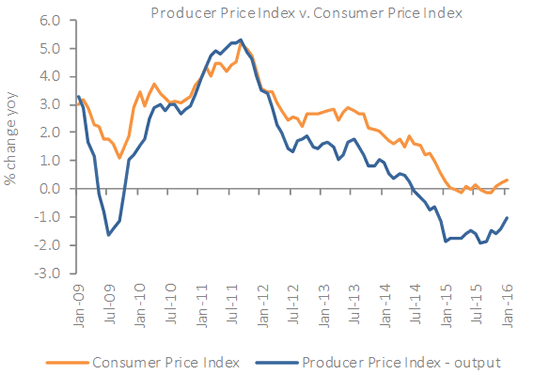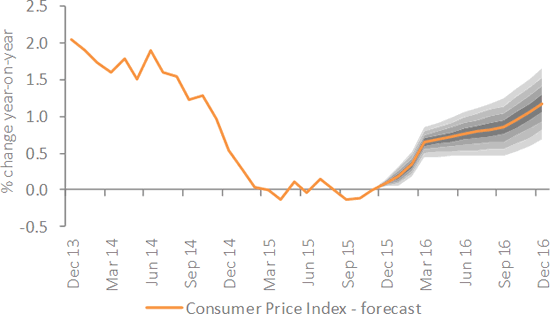Inflation edges up for third consecutive month
The Consumer Price Index (CPI) was positive for a third consecutive month in January with prices rising +0.3 per cent, year-on-year – in line with consensus expectations. The main upward pressure came from easing fuel price deflation with, despite renewed weakness in the price of oil, prices falling more aggressively this time last year.Importantly, core inflation fell to +1.2 per cent in January from +1.4 per cent in the previous month suggesting that the Bank of England has increasing room for manoeuvre with regards to the first rate hike. The Governor, Mark Carney, recently stated that he would need to see a pick-up in core inflation before voting to increase the Bank Rate. Food remained deflationary in January with prices falling -2.8 per cent on the previous year. Food has now been deflationary for 19 consecutive months. As sharp decreases last year fall out of annual comparisons we expect food prices to begin to rise in late summer 2016. However, prices are expected to rise gradually commodity prices remain soft and competition from the discounters remains fierce.The Producer Price Index for output (PPI), which is indicative of costs faced by retailers, showed factory gate prices fell by -1.0 per cent in January, which is the shallowest decline since November 2014.
Costs facing retailers continue to decline 
Source: ONSThe combination of lower oil prices, now hovering around $30 per barrel, the continued slow-down in China (now the slowest growth since 1990) and depreciation of the renminbi will support cheaper imports in the coming months. However, with even sharper falls in petrol and food this time last year soon to drop out of annual comparisons, the overall impact will be for consumer prices to slowly edge up over the course of the year. Further, imported goods prices are likely to rise as past rises in Sterling fall out of annual comparisons. So despite a return to inflation, the outlook remains weak. The Bank of England’s target of 2 per cent inflation is unlikely to be reached for another two years. We do not expect inflation to reach 1 per cent until the end of 2016 in our central forecast provided there are no shocks to supply chains. The recent announcement of Saudi Arabia, Qatar, Russia and Venezuela to freeze oil production at its January levels, if other oil-producing countries do the same, will see oil prices return to more normal levels in the medium term. However, there is considerable uncertainty over whether other countries will follow suit and the scale of pull-back in production.
Outlook for inflation remains weak
Source: Retail Economics analysisAssuming there are no shocks to commodity prices, CPI is expected to remain below zero and 1 per cent for the main part of 2016, reflecting the continued drag from commodity and other imported goods prices. Given that recent labour market statistics revealed wage growth remains lacklustre, the back drop of easing core inflation suggests that any rise in interest rates will have been pushed back further. The Monetary Policy Committee (MPC) judges that it is likely that interest rates will follow a very gradual and rising path implied by market yields.So overall, low inflation remains supportive to UK household spending. Combined with continued low interest rates, rising demand for credit and robust consumer confidence, consumer spending is expected to remain robust. While January’s retail sales figures reported by the BRC showed surprisingly robust growth, we remain cautious that the positive backdrop for household will trickle through to the retail industry in the immediate future.
Back to Retail Economic News